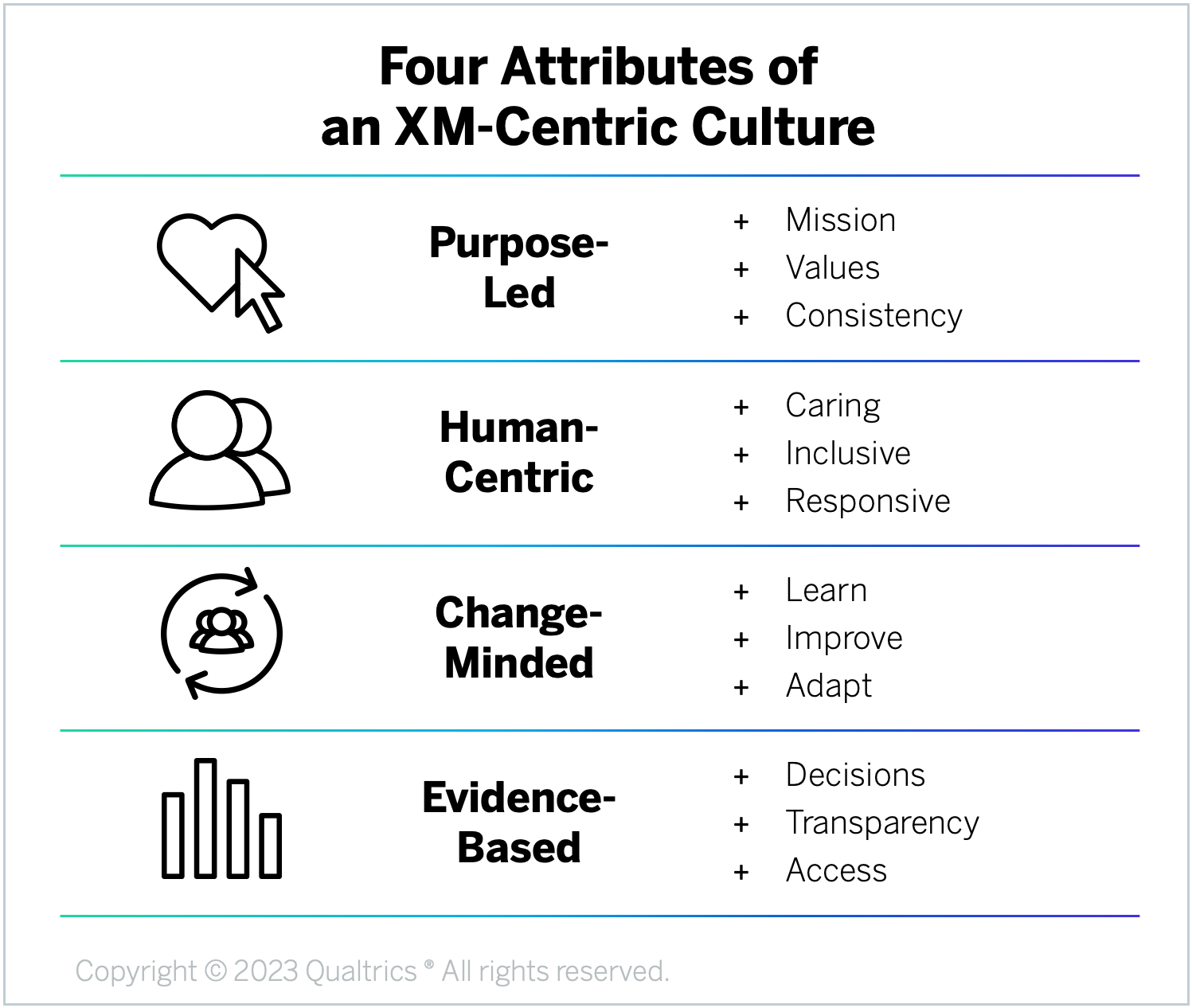As we’ve described in the XM Operating Framework, organizational Culture is one of the three building blocks of a successful Experience Management (XM) program, along with Technology and Competencies. What do we mean by “culture?” Simply put, it’s how employees think, believe, and act.
XM programs are really about driving change. To achieve long-term XM success, organizations need the ambition to change, the Technology to scale the change, the Competencies to drive the change, and the Culture to support the change. This last element is critical as change will ultimately be impossible if you encounter significant internal resistance to your XM efforts. Culture can either inhibit XM efforts, if the prevailing mindsets and beliefs go against desired XM-centric behaviors, or it can nurture and accelerate the adoption of those behaviors, providing fertile ground for XM Competencies and Technologies to take root.
Assessing Your XM-Centric Culture
Culture is one of those “things” that everyone recognizes but few can satisfactorily define, and even fewer understand how to influence it. Rather than trying to examine every aspect of an organization’s culture, XM Institute has identified four attributes that are aligned with the goals of many XM programs: Purpose-Led, Human-Centric, Change-Minded, and Evidence-Based. To provide clarity around this “squishy” topic, we’ve created an XM-Centric Culture Assessment, which examines the frequency of 12 distinct characteristics across those four attributes.

Purpose-Led
The organization operates consistently with a clear direction and a well-understood set of values. Having a shared organizational purpose will align, motivate, and empower people across the business. In a Purpose-Led culture, the organization’s mission drives decision-making and its stated values drive behaviors, allowing people to understand and anticipate how decisions will be made and adjust their behavior accordingly. The assessment examines these characteristics of a Purpose-Led organization:
- Mission: Employees are motivated by the organization’s mission
- Values: Employees use the organization’s values to guide their decisions
- Consistency: Leaders behave consistently with a clearly articulated set of organizational values
Human-Centric
The organization demonstrates empathy for its customers and employees. Experiences are created and consumed by human beings (customers, employees, partners, etc.), so organizations must cater to how people actually think, feel, and act. In a Human-Centric culture, the organization recognizes that business success is driven by engaged employees and loyal customers, so it treats employees as critical assets who need to feel engaged and customers as human beings who need their emotional needs met. The assessment examines these characteristics of a Human-Centric organization:
- Caring: Leaders actively seek to understand what customers and employees are thinking and feeling
- Inclusive. The organization treats all employees as valuable members of a single team
- Responsive. The organization treats customers differently based on their individual needs
Change-Minded
The organization regularly makes improvements without significant internal resistance. For any major XM initiative to succeed, many employees will inevitably have to change their behaviors. In a Change-Minded culture, people embrace the idea that adjusting is a way of life and actively seek to learn from successes and failures, applying what they uncover to future attempts. The assessment examines these characteristics of a Change-Minded organization:
- Learn: Employees treat mistakes as learning opportunities, rather than assigning blame or punishment
- Improve: The organization regularly makes improvements to the way that it operates
- Adapt: Employees demonstrate a willingness to embrace new ideas and adapt to change
Evidence-Based
The organization relies on data and analysis to make key decisions. Fundamentally, Experience Management is about making smarter, faster decisions with data. For XM practices to take root, people across the business need to embrace the potential of data insights to help them in their everyday roles. In an Evidence-Based culture, people make decisions based on facts rather than intuition and constantly look for ways that data analysis can provide more useful recommendations to guide their decisions and behaviors. The assessment examines these characteristics of an Evidence-Based organization:
- Decisions: Leaders engage in data-informed decision-making, rather than relying on intuition
- Transparency: The organization shares data and insights that enable transparency and collaboration
- Access: Employees have access to the data and tools they need to make well-informed recommendations
Using The XM-Centric Culture Assessment
The assessment identifies the degree to which each of these four areas of culture is nurturing or inhibiting your XM efforts. Use this tool to identify and align around potential areas you could improve by amplifying the positive aspects of your culture or mitigating the negative ones. Here’s how we suggest using this assessment:
- Self-assessments. Take the test yourself and identify the headwinds and tailwinds of your organization’s culture. You can also use the evaluation to assess different departments or business units.
- Group discussions. Have multiple people complete the self-assessment and then review the results as a group. Discuss the nurturing and inhibiting elements you’ve identified as well as which areas you all agree on and which areas you disagree on.
- Action planning. Delivering XM does not always require long-term cultural shifts or large-scale change management. Instead, think about what small, but consistently applied, changes could positively influence how people think, believe, and act.
- Progress tracking. Repeat the self-test every 12 to 18 months to track your progress and identify your key areas of focus. The goal is to drive an ongoing discussion and continue evolving your culture.
The bottom line: Make sure your culture is nurturing, not inhibiting, your XM efforts.
Bruce Temkin, XMP, CCXP, is the Head of Qualtrics XM Institute
Isabelle Zdatny, XMP, CCXP, is an XM Catalyst with the Qualtrics XM Institute





